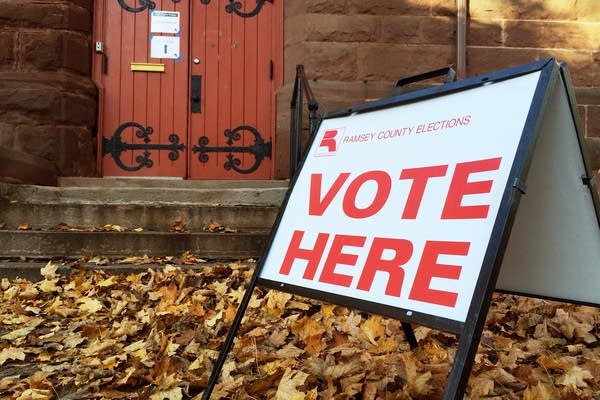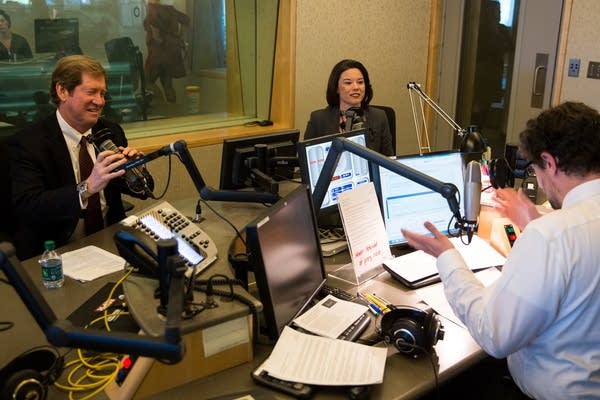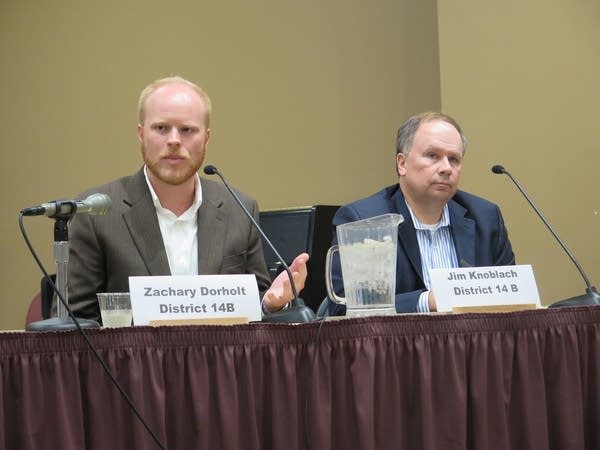Minnesota voters, here's your election guide

Go Deeper.
Create an account or log in to save stories.
Like this?
Thanks for liking this story! We have added it to a list of your favorite stories.
Election Day is Nov. 8. From the presidential race to the constitutional amendment, here's your guide to who — and what — is on the ballot.
Polls are already open in Minnesota (sort of) if you want to vote now. Early or absentee voting began in September and lasts until 5 p.m. on Nov. 7, the day before Election Day.
The race for the White House
Turn Up Your Support
MPR News helps you turn down the noise and build shared understanding. Turn up your support for this public resource and keep trusted journalism accessible to all.

Minnesota has the nation's longest streak of backing a Democratic candidate for the White House. Hillary Clinton is favored to keep that run intact. Republican Donald Trump hasn't devoted much time, money or effort to the state, and it was one of his weakest in the primary season.
The real question mark is whether any third-party candidate does well enough to add a new major party to the state's ranks in time for 2018; it would take a 5 percent or more vote haul for that to happen.
In all, there are nine candidates on the ballot. Along with Clinton and Trump, they include the Libertarian Party's Gary Johnson, Green Party candidate Jill Stein and Evan McMullin representing the Independence Party.
Constitutional amendment
Voters will decide whether to change the way lawmaker pay is set.
If they approve a question on the ballot, an independent commission would be established to set legislator salaries.
Currently, it's up to the Legislature to determine pay, but they haven't approved a raise since 1999.
Amendment supporters argue the current setup is an inherent conflict of interest, and they say the political fear factor has suppressed pay and made it hard to recruit potential legislators.
Opponents say it should be difficult to raise pay and a commission is almost certain to hike salaries.
Amendments require a majority of all of the voters in the election, so "no" votes and blank votes both count against passage.
The commission would be made up of eight Democrats and eight Republicans. Half would be appointed by the governor and half by the chief justice of the Minnesota Supreme Court. No members of the panel could be legislators or former legislators, their spouses, judges, lobbyists or state employees.
Minnesota Supreme Court
Voters will decide a seat on the state Supreme Court.
Associate Justice Natalie Hudson was appointed to the post by Gov. Mark Dayton last year. She is facing a challenge from attorney Michelle MacDonald.
Hudson previously served 13 years on the Minnesota Court of Appeals. She also had stints as a legal aid lawyer, city attorney and law school administrator. As a candidate, Hudson is stressing her experience and her temperament.
MacDonald is an attorney specializing in family law who's made news for some of her own legal troubles. MacDonald is making her second run for the state Supreme Court. She narrowly lost to Associate Justice David Lillehaug in 2014.
Congress
1st Congressional District
Where: Runs from the Wisconsin to South Dakota borders across southern Minnesota, encompassing Mankato, Rochester and Winona.
Who: DFL Rep. Tim Walz is in a rematch with Republican nominee Jim Hagedorn, a former federal official and the son of a former congressman. Walz beat Hagedorn by a 54-46 margin in 2014.
Why it matters: After being targeted heavily in earlier races, Walz has been off the radar of competitive races of late. He's talked about as a possible statewide candidate in 2018 or beyond. But Walz also came out of nowhere to win the seat in 2006, so he's keen to the possibility of upsets.

2nd Congressional District
Where: A district that stretches south and east of Minneapolis and St. Paul from Eagan past Wabasha covering many suburbs and exurbs.
Who: Democrat Angie Craig, a former medical device company executive, faces Republican Jason Lewis, a former radio personality. The Independence Party candidate is Paula Overby.
Why it matters: There is no incumbent, given Republican Rep. John Kline's retirement. That's made the race expensive and intense. Democrats think high turnout in the presidential race could help flip the seat to them, but Republicans are spending millions on behalf of Lewis.
3rd Congressional District
Where: Comprises much of suburban Hennepin County and small slices of Wright and Carver counties.
Who: Republican Rep. Erik Paulsen is in the toughest race since his first congressional election versus DFL state Sen. Terri Bonoff.
Why it matters: Paulsen has run up huge win margins in every race since 2008 and has always outperformed the top of his ticket, leading to speculation he could run statewide one day. But he's working to get beyond stiff Trump headwinds in the district as Democrats spend millions to link the Republicans. Paulsen and Republicans have mined Bonoff's legislative voting record.
4th Congressional District
Where: St. Paul and some adjoining suburbs to the north and east to the Wisconsin border.
Who: DFL Rep. Betty McCollum is in a race with the GOP's Greg Ryan, a plumbing company owner. A third candidate on ballots is Susan Pendergast Sindt of the Legal Marijuana Now Party.
Why it matters: McCollum is heavily favored in her bid for a ninth term. She has worked her way into House leadership.
5th Congressional District
Where: Minneapolis and nearby suburbs.
Who: Democratic Rep. Keith Ellison faces Republican Frank Drake, a realtor. Legal Marijuana Now candidate Dennis Schuller is also running.
Why it matters: Ellison is a highly visible member of the delegation and prominent in the national Democratic Party's left flank. He was an early and vocal supporter of Bernie Sanders during the primary season.
6th Congressional District
Where: Central Minnesota from western and northern Twin Cities suburbs past St. Cloud.
Who: Republican Rep. Tom Emmer is opposed by DFLer David Snyder, an iron worker and former Army helicopter pilot.
Why it matters: Emmer is a strong favorite for a second term. He has run statewide before (narrowly losing the 2010 governor's race) and could try again — for governor or U.S. Senate down the road.
7th Congressional District
Where: A huge swath of western Minnesota from the Canadian border to just north of the Iowa border.
Who: Democratic Rep. Collin Peterson is competing with Republican Dave Hughes, a pilot and Air Force veteran.
Why it matters: Peterson is the dean of Minnesota's delegation, having served in Congress for a quarter of a century and being watched closely for signals of retirement. He represents a district strongly inclined to Republicans in presidential races but has won most of his races in convincing fashion.
8th Congressional District
Where: A giant district spanning from the Twin Cities exurbs to far northeastern Minnesota.
Who: DFL Rep. Rick Nolan is in a second dogfight with Republican Stewart Mills of the Fleet Farm family.
Why it matters: It is far and away Minnesota's most expensive race and one of the priciest in the country. The once reliable Democratic district has turned routinely competitive and will remain so for the foreseeable future. Expect a late night of vote counting.

Legislature
All 201 seats in the Minnesota Legislature are on the ballot Nov. 8. But control of the House and Senate will likely be decided in a handful of battleground districts.
Here are some of the key races to watch:
Minnesota Senate
The DFL currently holds a 10-seat advantage over Republicans, 38 to 28 with one vacant seat. The GOP would need to gain six seats for flip.
District 1 (northwestern Minnesota): The contest for this open and currently DFL seat is between DFLer Kip Fontaine and Republican Mark Johnson. Republicans are hoping to flip a seat that was held by Democrat LeRoy Stumpf since 1983.
District 2 (northwestern Minnesota): Incumbent Sen. Rod Skoe, DFL-Clearbrook, the powerful Senate tax chair, is facing a challenge from Republican Paul Utke. In what could be Trump country, this will be a test of his coattails.
District 14 (St. Cloud area): There is a three-way race for this open seat, which is currently in GOP hands: Republican Jerry Relph, DFLer Dan Wolgamott and Libertarian Party candidate Steven Zilberg. Among the most uncertain of races heading into Election Day.
District 17 (west-central Minnesota): Incumbent Sen. Lyle Koenen, DFL-Clara City, is facing a challenge from Republican Andrew Lang. With two Republican House members in the area, it was a tantalizing Senate target for the GOP.
District 21 (Red Wing area): First-term Sen. Matt Schmit, DFL-Red Wing, is facing a challenge from Republican Mike Goggin. Schmit toppled an incumbent four years ago and has been fighting hard to avoid the same fate.
District 24 (south-central Minnesota): First-term incumbent Sen. Vicki Jensen, DFL-Owatonna, is facing a challenge from Republican John Jasinski, who is the mayor of Faribault. Both sides consider this a top-tier race.
District 36 (northern suburbs): First-term incumbent Sen. John Hoffman, DFL-Champlin, is facing a challenge from Republican Jeffrey Lunde, the mayor of Brooklyn Park. Hoffman beat a sitting senator in 2012 and is facing one of the GOP's strongest recruits.
District 44 (western suburbs): With the DFL incumbent retiring, the battle for the open seat is between Republican Paul Anderson and DFLer Deb Calvert. Anderson, a former staffer to Gov. Tim Pawlenty, is getting help from Pawlenty office alumni, but Republicans are on a four election losing streak here.
District 48 (Eden Prairie area): Senate Minority Leader David Hann, R-Eden Prairie, is facing a challenge from DFL candidate Steve Cwodzinski. Caucus leaders seldom fall to electoral defeat and Hann is fighting to avoid becoming the first since 2006.
District 58 (Lakeville area): Republican Tim Pitcher and DFLer Matt Little are running for this open seat, which was vacated by a Republican retirement. If the DFL wins here, it could be a sign of a wave election in the state.
Minnesota House
Republicans currently hold a 12-seat advantage over DFL, 73 to 61. The DFL would need to gain seven seats to flip.
District 2A (northern Minnesota): Republican Matthew Grossell and DFLer Jerry Loud are after the open seat, which was last in GOP hands. The DFL Party abandoned the race after Loud's troubled past surfaced.
District 5A (northern Minnesota): Incumbent Rep. John Persell, DFL-Bemidji, has Republican Matt Bliss as an opponent. Two big turnout forces to watch: Trump voters and the American Indian reservations in the district.
District 5B (northeastern Minnesota): Incumbent Rep. Tom Anzelc, DFL-Balsam Township, has two challengers: Republican Sandy Layman, a former IRRRB commissioner, and Green Party candidate Dennis Barsness. The Trump factor looms here and Anzelc's return could be dependent on split-ticket voters.
District 12A (western Minnesota): First-term Rep. Jeff Backer, R-Browns Valley, will again face DFLer Jay McNamar, who lost the seat to Backer in 2014. The script for the sequel much like the original: It's about who has the pulse of the rural district.

District 14B (St. Cloud): In another rematch, House Ways and Means Chair Jim Knoblach, R-St. Cloud, is facing DFLer Zach Dorholt. This will go down as one of the most expensive around, with loads of outside money pouring in.
District 17A (west-central Minnesota): First-term Rep. Tim Miller, R-Prinsburg, will again face DFLer Andrew Falk, who served three House terms. If Miller survives his first re-election test, he's probably in a good spot to hold the seat for years to come.
District 17B (west-central Minnesota): First-term Rep. Dave Baker, R-Willmar, will again face DFLer Mary Sawatzky. Baker was pushed to the head of his freshman GOP class as an assistant majority leader, but this race could be a photo finish.
District 21A (Red Wing area): DFL candidate Lisa Bayley is battling Republican Barb Haley for this open seat that is currently a GOP seat. House Republicans can't afford to lose seats like this if they want to keep their majority.
District 24B (Faribault area): First-term Rep. Brian Daniels defeated longtime DFL incumbent Patty Fritz two years ago. Fritz wants the seat back. It's almost as if Fritz never stopped running, but Daniels hasn't let up either.
District 25B (Rochester): Former Republican lawmaker Fran Bradley came out of retirement to run against DFL candidate Duane Sauke, for a seat opened up by a DFL retirement. The DFL knows it can't lose here if it hopes to cobble together a majority with any breathing room.
District 44A (western suburbs): House State Government Finance Chair Sarah Anderson, R-Plymouth, is trying to fend off DFLer Ginny Klevorn. An Anderson loss would be a bad sign for the House GOP's chances to retain control.
District 48A (western suburbs): Another open seat, this time a DFL retirement, features Republican Mary Shapiro and DFL candidate Laurie Pryor. Top-of-the-ticket turnout forces could determine the victor.
District 56A, (Burnsville): First-term Rep. Drew Christensen, R-Burnsville, faces DFLer Jared Christiansen. Voters may need crib notes to remember Christensen from Christiansen.
District 56B (southern Suburbs): First-term Rep. Roz Peterson, R-Lakeville, is facing a challenge from DFLer Lindsey Port. This seat is the most swingy around, with the parties trading control from cycle to cycle.
District 57A (southern suburbs): With another GOP retirement, the contest for this open seat is between Republican Ali Jimenez-Hopper and DFL candidate Erin Maye Quade. There's no shortage of money or candidate hustle here, so this one is a coin flip.
District 57B (southern suburbs): Incumbent Rep. Anna Wills, R-Apple Valley, is facing a challenge from DFLer John Huot. Wills has notched two comfortable wins, so even having this race on the radar shows the year's volatility.
Dear reader,
Your voice matters. And we want to hear it.
Will you help shape the future of Minnesota Public Radio by taking our short Listener Survey?
It only takes a few minutes, and your input helps us serve you better—whether it’s news, culture, or the conversations that matter most to Minnesotans.



